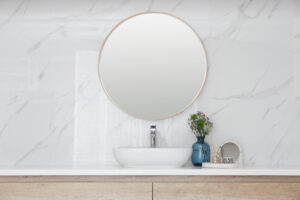What is the Most Durable Material for Bathroom Vanity Tops

*Updated March 18th, 2025
What are the Common Materials Used for Bathroom Vanity Tops?
Your bathroom vanity top plays a crucial role in both the style and functionality of your space. Since it endures daily wear and tear—from water splashes to soap spills and everything in between—it’s important to choose a material that balances durability, maintenance, and aesthetics. Fortunately, there are several great options to consider, each with its own unique advantages.
Some of the most popular materials for bathroom vanity tops include:
- Quartz
- Granite
- Marble
- Solid Surface
- Laminate
- Tile
What Should You Look for?
Not all bathroom vanity tops are created equal, and the right choice for you will depend on a few key factors. Think about how much daily use your vanity will see—will it be in a high-traffic family bathroom or a low-maintenance guest bath? Some materials handle water and humidity better than others, while some are more prone to stains, scratches, or chipping.
You’ll also want to consider maintenance. Do you prefer a low-maintenance option that only requires a quick wipe-down, or are you okay with sealing and polishing to maintain a luxurious look? Durability is another big factor—especially if you have kids or frequently use hair styling tools, makeup, and cleaning products that can leave marks over time.
As we explore each material, keep these features in mind so you can find a vanity top that fits your lifestyle, budget, and design preferences. Let’s break down the pros and cons of each option!
Quartz
Quartz is great because it doesn’t allow water, stains, or bacteria to seep through. It doesn’t need sealing and can handle most bathroom products without getting damaged. Just avoid using strong chemicals that might scratch its surface.
Granite
Granite is strong and can handle high temperatures and scratches. But, it has tiny holes that can let water and stains through, so it needs to be sealed regularly. Also, it’s best to clean up spills quickly to prevent marks.
Marble
Marble looks beautiful and adds a touch of class to any bathroom. However, it can get scratched and stained easily. Since it’s quite porous, it needs regular sealing and gentle cleaning to keep looking good.
Solid Surface
This synthetic material can mimic the look of natural stone or wood. It is good at resisting stains and water, and it’s easy to repair if damaged. But, keep it away from direct sunlight to prevent fading.
Laminate
Laminate is a budget-friendly option that offers a variety of colors and patterns. It is easy to clean but isn’t as long-lasting as other materials. It can get damaged by water and high temperatures, so you’ll need to be careful with it.
Tile
Tile lets you create your own designs and is resistant to heat, scratches, and stains. But the grout lines need regular cleaning to prevent dirt buildup, and it can crack if you drop something heavy on it.
How Does the Price of a Vanity Top Correlate with Its Durability?
When you’re choosing a vanity top, it can be tempting to think that a higher price tag means a more durable product. But is it always true? Let’s find out if shelling out more bucks really guarantees you a vanity top that will stand the test of time.
It’s not always black and white when it comes to the correlation between the cost and durability of vanity tops. While some options might be pricier due to their quality or rarity, others might have a friendly price tag due to easier production methods or popular demand.
In general, materials like quartz, granite, and marble tend to be on the expensive side of the spectrum, offering both beauty and durability. But even these materials have their own set of challenges. For example, quartz might not be the best friend of direct sunlight, granite requires regular sealing to prevent stains, and marble can get scratched quite easily.
On the flip side, materials like laminate and tile are more budget-friendly but might not last as long. These options do come with their own set of benefits that can extend their lifespan, like good resistance to water damage (laminate) or heat and stains (tile), if installed and maintained properly.
If you’re looking for something that balances cost and durability, a solid surface material could be your go-to. It replicates the look of more expensive materials but at a more moderate price point. However, it too has limitations, including susceptibility to damage from heat and scratches.
Final Thoughts
Your bathroom vanity top is more than just a surface—it’s a key part of your daily routine and a major contributor to your bathroom’s overall look and feel. Choosing the right material is a smart investment that can save you time, money, and hassle in the long run by reducing maintenance and ensuring long-lasting durability.
That said, the best choice isn’t just about durability or cost. It’s also about finding a material that fits your lifestyle, maintenance preferences, and personal style. Do you love the elegance of marble, or do you need the worry-free durability of quartz? Are you looking for a budget-friendly option like laminate, or do you prefer the timeless, natural beauty of granite?
By weighing the pros and cons of each material, you can make an informed decision that not only meets your functional needs but also enhances the look of your bathroom. No matter your choice, a well-chosen vanity top can add value to your home and make your bathroom a space you love for years to come.
FAQs
How to Accurately Measure Your Bathroom Vanity Top?
Measuring your vanity top is a crucial step to ensure a good fit. Here’s a simple step-by-step guide:
- Length: Measure from one end to the other end of the existing vanity top or the space where it will be placed.
- Depth: Measure from the back wall to the front edge where the vanity top will be installed.
- Sink Cut-Out: If your vanity top will house a sink, don’t forget to measure the length and width of the sink to determine the cut-out dimensions.
Remember to always double-check your measurements to avoid any costly mistakes.
How to Choose the Right Color and Style for My Vanity Top?
Choosing the right color and style is about aligning with the overall theme of your bathroom. Consider the following tips:
- Choose colors that complement other elements in your bathroom.
- Ensure the style of the vanity top resonates with the existing decor or the decor you are aiming for.
- Lastly, let your personal taste guide you. Whether you prefer a modern minimalist approach or a classic style, make sure it’s something you’ll love for years to come.
Additional Bathroom Remodel Resources

Anna has over six years of experience in the home services and journalism industries and serves as the Content Manager at MyHomePros.com, specializing in making complex home improvement topics like HVAC, roofing, and plumbing accessible to all. With a bachelor’s degree in journalism from Auburn University, she excels in crafting localized, comprehensive guides that cater to homeowners’ unique needs. Living on both coasts of the United States has equipped her with a distinctive perspective, fueling her passion for turning any house into a cherished home through informed, personalized decision-making.








